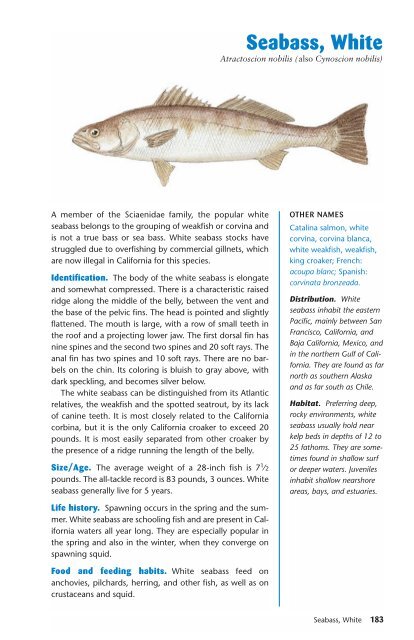Ken Schultz's Field Guide to Saltwater Fish - Macaw Pets store
Ken Schultz's Field Guide to Saltwater Fish - Macaw Pets store
Ken Schultz's Field Guide to Saltwater Fish - Macaw Pets store
Create successful ePaper yourself
Turn your PDF publications into a flip-book with our unique Google optimized e-Paper software.
A member of the Sciaenidae family, the popular white<br />
seabass belongs <strong>to</strong> the grouping of weakfish or corvina and<br />
is not a true bass or sea bass. White seabass s<strong>to</strong>cks have<br />
struggled due <strong>to</strong> overfishing by commercial gillnets, which<br />
are now illegal in California for this species.<br />
Identification. The body of the white seabass is elongate<br />
and somewhat compressed. There is a characteristic raised<br />
ridge along the middle of the belly, between the vent and<br />
the base of the pelvic fins. The head is pointed and slightly<br />
flattened. The mouth is large, with a row of small teeth in<br />
the roof and a projecting lower jaw. The first dorsal fin has<br />
nine spines and the second two spines and 20 soft rays. The<br />
anal fin has two spines and 10 soft rays. There are no barbels<br />
on the chin. Its coloring is bluish <strong>to</strong> gray above, with<br />
dark speckling, and becomes silver below.<br />
The white seabass can be distinguished from its Atlantic<br />
relatives, the weakfish and the spotted seatrout, by its lack<br />
of canine teeth. It is most closely related <strong>to</strong> the California<br />
corbina, but it is the only California croaker <strong>to</strong> exceed 20<br />
pounds. It is most easily separated from other croaker by<br />
the presence of a ridge running the length of the belly.<br />
Size/Age. The average weight of a 28-inch fish is 7 1 ⁄2<br />
pounds. The all-tackle record is 83 pounds, 3 ounces. White<br />
seabass generally live for 5 years.<br />
Life his<strong>to</strong>ry. Spawning occurs in the spring and the summer.<br />
White seabass are schooling fish and are present in California<br />
waters all year long. They are especially popular in<br />
the spring and also in the winter, when they converge on<br />
spawning squid.<br />
Food and feeding habits. White seabass feed on<br />
anchovies, pilchards, herring, and other fish, as well as on<br />
crustaceans and squid.<br />
Seabass, White<br />
Atrac<strong>to</strong>scion nobilis (also Cynoscion nobilis)<br />
OTHER NAMES<br />
Catalina salmon, white<br />
corvina, corvina blanca,<br />
white weakfish, weakfish,<br />
king croaker; French:<br />
acoupa blanc; Spanish:<br />
corvinata bronzeada.<br />
Distribution. White<br />
seabass inhabit the eastern<br />
Pacific, mainly between San<br />
Francisco, California, and<br />
Baja California, Mexico, and<br />
in the northern Gulf of California.<br />
They are found as far<br />
north as southern Alaska<br />
and as far south as Chile.<br />
Habitat. Preferring deep,<br />
rocky environments, white<br />
seabass usually hold near<br />
kelp beds in depths of 12 <strong>to</strong><br />
25 fathoms. They are sometimes<br />
found in shallow surf<br />
or deeper waters. Juveniles<br />
inhabit shallow nearshore<br />
areas, bays, and estuaries.<br />
Seabass, White 183


